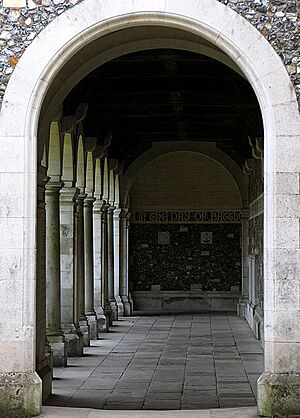Winchester College War Cloister facts for kids

The Winchester College War Cloister is a special memorial at Winchester College in Hampshire, England. It was designed by a famous architect named Sir Herbert Baker. This covered outdoor area is thought to be the largest private war memorial in all of Europe! It's a very important building, recognized as a Grade I listed building because of its history and design.
Contents
Why Was This Memorial Built?
The idea for this memorial came from the school's headmaster, Montague Rendall. He wanted to remember the 500 students and staff from Winchester College, called Wykehamists, who died in World War I. To give you an idea, at that time, only about 450 boys attended the school! Many more Wykehamists were injured, and about 900 received awards for their bravery.
Around 2,500 people connected to Winchester College served in the British armed forces during the war. Four of them were even awarded the Victoria Cross, which is the highest military award for bravery. Three of these brave men, Captain Arthur Kilby, Second Lieutenant Dennis Hewitt, and Lieutenant Colonel Charles Doughty-Wylie, died during the war. Lieutenant Colonel Daniel Burges was the only one of the four to survive.
How the Idea Became Reality
The first idea for a school memorial came up as early as 1915. Initially, people thought about building a large memorial hall. But over time, the plans grew to include a new set of rooms around a cloister, which is a covered walkway.
Sir Herbert Baker was chosen as the architect. He started making plans in 1918. However, this big project was too expensive, and the plans had to be made smaller in 1921. The new plan focused on building just the cloister. It also included rebuilding parts of the school chapel and setting up funds to help educate the sons of the Wykehamists who had died.
The new cloister was built next to the school's older medieval buildings. These original buildings were put up in the 1390s by the school's founder, William of Wykeham. The first stone for the War Cloister was laid on July 15, 1922, by Edward Grey, 1st Viscount Grey of Fallodon.
What Does the Cloister Look Like?
The War Cloister is built from special materials like knapped flint and Portland stone. The arches of the cloister are made of Portland stone. They have round tops and are supported by strong Tuscan columns.
The roof is supported by an oak structure and covered with tiles made from Purbeck stone. The walls, supports, and roof beams are decorated with badges from 120 different regiments. These are the military groups where men from the school served. These designs were created by George Kruger Gray and painted by Laurence Arthur Turner. You can also see carved wooden angels on the roof!
Above the main arches in the center of the cloister, there are badges from four regiments especially connected to the school. These are the Rifle Brigade, the King's Royal Rifle Corps, the Hampshire Regiment, and the Royal Artillery.
Special Corners and Stones
At each of the four corners of the cloister, there is a special curved area called an apse. Each apse is dedicated to a different part of the world where Wykehamists served:
- The southeast apse is for South Africa.
- The southwest apse is for Australia.
- The northwest apse is for Canada.
- The northeast apse is for India.
Each apse has a large, round stone on the floor. These stones come from important places: granite from Table Mountain in South Africa, syenite from New South Wales, marble from Texada Island in British Columbia, and black marble from Budh Gaya in India. There are also four small stones from Ypres, a famous battlefield, set into the floor near the Meads Gate.
Names and Garden
The names of those who died in World War I are carved on the outer wall of the cloister. They are listed on tablets made of Hopton Wood stone. There are eight large tablets in total, each made up of six smaller panels with names.
Inside the cloister, there is a beautiful garden designed by Gertrude Jekyll. It has lovely roses and white lilies, with four grassy areas separated by paths. These paths lead to a central memorial cross. This cross was made by the sculptor Alfred Turner. It's a Latin cross with a wheel shape at the top, standing on an eight-sided base with three steps. On either side of the cross, there is a carved figure of a crusader knight.
Gates and Inscriptions
The school's art master, Reginald Gleadowe, designed the main gate leading to the Meads. This gate is decorated with angels blowing trumpets. Above the entrance arch, there is a carving of the school's patron, St Mary, made by Charles Wheeler.
You can also enter the cloister from Kingsgate Street through the South Africa Gate. This gate remembers the Wykehamists who died in the Second Boer War. The Victory Gate to the south leads to other school buildings.
Reginald Gleadowe also designed the special writing style, called Lombardic script, used for the main message carved around the outer wall of the cloister. This message is a powerful tribute:
THANKS BE TO GOD FOR THE SERVICE OF THESE FIVE HUNDRED WYKEHAMISTS, WHO WERE FOUND FAITHFUL UNTO DEATH AMID THE MANIFOLD CHANCES OF THE GREAT WAR. IN THE DAY OF BATTLE THEY FORGAT NOT GOD, WHO CREATED THEM TO DO HIS WILL, NOR THEIR COUNTRY, THE STRONGHOLD OF FREEDOM, NOR THEIR SCHOOL, THE MOTHER OF GODLINESS AND DISCIPLINE. STRONG IN THIS THREEFOLD FAITH THEY WENT FORTH FROM HOME AND KINDRED TO THE BATTLEFIELDS OF THE WORLD AND, TREADING THE PATH OF DUTY AND SACRIFICE, LAID DOWN THEIR LIVES FOR MANKIND. THOU, THEREFORE, FOR WHOM THEY DIED, SEEK NOT THINE OWN, BUT SERVE AS THEY SERVED, AND IN PEACE OR IN WAR BEAR THYSELF EVER AS CHRIST'S SOLDIER, GENTLE IN ALL THINGS, VALIANT IN ACTION, STEADFAST IN ADVERSITY


